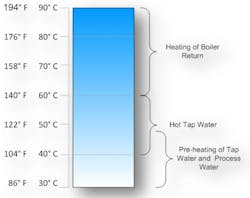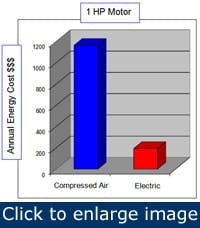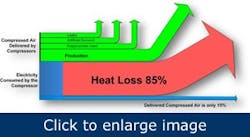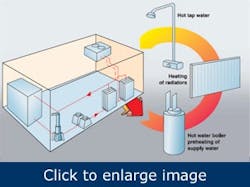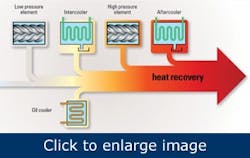Compressed air systems' waste heat improves plant economics
In brief:
- Energy recovery from compressed air installations doesn’t always result in heat being available exactly when it’s required and sometimes not in sufficient quantities.
- Most new compressors from the major suppliers can be adapted to or be supplemented with standard heat recovery equipment.
- The temperature of recovered energy determines the possible application areas and thereby the value of it.
- Heat recovery for space heating requires an extra stage of heat exchange and the temperature possibilities are lower.
- Compressed air systems represent an excellent source for heat recovery and could improve overall system efficiency.
When air is compressed, it heats up – it’s simple physics. The heat energy is concentrated in a decreasing volume of air. To maintain proper operating temperatures, the compressor must transfer the excess heat to a cooling medium before the air enters the distribution system. As much as 90% of that heat can be recovered for use in your operation. If you can supplement or replace the electricity, gas or oil needed to heat water for washrooms, or direct warm air into a workspace, warehouse, loading dock or entryway, the savings can add up. The possibilities to recover this waste heat via hot air or hot water are good. The return on the investment for energy recovery typically is as short as one to three years. In addition, if the energy is recovered by means of a closed-loop cooling system, for water-cooled compressors, the compressor runs cooler, increasing reliability and service life because of better operating conditions such as equal temperature levels and high cooling water quality.
Did you know?
Figure 1. A compressed air motor consumes eight times more energy than an electric motor. (Source: Compressed Air Challenge)
The power input for a 1 hp “air” motor requires almost 8 hp versus 1 hp required for a direct-drive electric motor (Figure 1). Which makes more sense?
As participants of Compressed Air Challenge’s Fundamentals of Compressed Air seminars learn, the energy cost comparison is $1,349 using compressed air or $168 using an electric motor for five days/week in a two-shift operation at $0.05/kWh.
The losses that produce this difference occur on both the supply and demand sides — heat of compression losses on the supply side and wasted air on the demand side. Compressed air is a necessary part of most plant operations, but it isn’t the most efficient source of energy in a plant. Recovering and redirecting the heat normally shed from compressing air can offset some of the waste and operating costs associated with compressed air. A central compressor plant in a large industry that consumes 500 kW during 8,000 operating hr/year represents a yearly energy consumption of 4 million kWh. The possibilities for recovering substantial amounts of waste heat via hot air or hot water are real.
Having a fundamental understanding of how your plant’s compressed air system works and which forces influence it can help you improve its performance and increase its reliability. The overall efficiency of a compressed air system can be as low as 10% to 15%. Figure 2 shows two main components of inefficiency; one is from the wasted air by losses through leaks, artificial demand and inappropriate uses. The other is from heat of compression. In most systems, production will see only 50% of the total air compressed from the supply side. With some basic understanding in the physics of how air is compressed, as much as 90% of that heat can be recovered for use in your operation.
Figure 2. Heat of compression represents 85% of the energy in compressed air production. (Source: Draw Professional Services.
Heat recovery case study
An electronics manufacturer has an electroplating operation that requires 20 gpm to 40 gpm of deionized (DI) water at a temperature of 131° F (55° C)) for a final rinsing process. It has 16 lines that require this flow. Insufficient water temperature leads to process problems. It takes 550 kW of energy in the form of steam and electric elements to heat this quantity of water.
The plant purchased a heat recovery package for three of its 450-hp oil-free rotary-screw compressors. With 80% to 90% heat of compression recovery, it now can heat 21 gpm per compressor at 90° C (194° F). This is more than enough water flow and temperature to handle the 16 plating lines. By adding in the heat recovery system, there’s no longer any need for the steam boiler or electrical heaters (550 kW), which had been required to heat this water. The plant has been using the system for more than two years and documented total energy savings of about $230,000 per year. The system cost about $100,000, plus installation.
Whether you run rotary-screw, centrifugal or reciprocating compressors, whether water-cooled or air-cooled, you can recover a good percentage of the waste heat it generates. The temperature of the recovered energy determines the possible application areas and thereby the value.
{pb}Figure 3. Water heated at various temperatures can have different uses. (Source: Draw Professional Services)
Figure 3 illustrates some typical applications for energy recovery available from the compressor cooling water in different temperature ranges. In the highest temperature level (from oil-free compressors) the degree of recovery is the greatest. The highest efficiency is generally obtained from water-cooled installations in which the compressor discharge cooling water can be connected directly to a continuous process heating system — for example, the heating boilers return circuit. Surplus energy then can be effectively used year-round. Most new compressors from the major suppliers can be adapted to or be supplemented with standard heat recovery equipment. In many cases the degree of heat recovery can exceed 90% if the energy captured can be used efficiently. The function of the cooling system, the distance to the point of consumption and the degree and continuity of the heat requirement are some of the decisive factors.
Energy recovery from compressed air installations doesn’t always result in heat being available exactly when it’s required and sometimes not in sufficient quantities. The instantaneous intensity of recovered energy can vary if the compressor has a variable load. The heat energy demand must be insensitive to these variations if recovery is to be feasible.
Figure 4. Compressor waste heat can be used to heat tap water, boilers or radiators. (Source: Atlas Copco)
The recovered waste heat energy can be best used to supplement the energy supplied by a primary system, such as process boilers or hot water systems that run all the time (Figure 4). This ensures the available waste energy is always used when the compressor is operating.
Heat recovery with rotary-screw compressors
Air-cooled, packaged, rotary-screw compressors are amenable to heat recovery for space heating or other hot air uses. Ambient atmospheric air is heated by passing it across the system’s aftercooler and lubricant cooler, where it extracts heat from both the compressed air and the lubricant used to lubricate and cool the compressor. This is relatively low temperature (under 100° F) heat and is therefore limited in its application.
As a rule, about 50,000 BTU/hr is available for each 100 cfm of capacity at full load. This value is based on 80% recoverable heat from the compressor and a conversion factor of 2,545 Btu/bhp-hr. You can heat the air 30° F to 40° F above the cooling air inlet temperature. Recovery efficiencies of 80% to 90% are common.
There is one cautionary factor you should know. When the compressor’s supply air isn’t from outside and the recovered heat is used in another space, the static pressure in the cabinet or room can decrease and reduce the compressor’s efficiency. A decrease in static pressure — negative pressure — has the same effect as throttling the compressor inlet, which changes the compression ratio, thus reducing efficiency. If outside air is used, some return air might be required to avoid damaging the compressor with below-freezing air.
Because packaged compressors typically are enclosed in cabinets and already include heat exchangers and fans, the only system modifications needed are the addition of ducting and possibly another fan to handle the duct loading to eliminate backpressure on the compressor cooling fan.
These heat recovery systems can be modulated with a simple, thermostatically controlled hinged vent. If heating isn’t required, such as durin the summer months, the hot air can be ducted outside the building. The vent also can be regulated thermostatically to provide a constant temperature for a heated area. Hot air can be used for space heating, industrial drying, preheating aspirated air for oil burners, or any other application requiring warm air.
{pb}Heat recovery with water-cooled compressors
Heat recovery for space heating isn’t as common with water-cooled compressors because it requires an extra stage of heat exchange and the temperature possibilities are lower. Because many water-cooled compressors are quite large, however, heat recovery for space heating can be an attractive opportunity. Recovery efficiencies of 50% to 60% are typical. With water-cooled, lubricant-injected rotary-screw compressors using a heat exchanger, it’s possible to extract waste heat from the lubricant coolers to produce hot water. Because of the possibility of tube failure, a double-wall lubricant cooler is often recommended.
[pullquote]Depending on design, secondary heat exchangers can warm nonpotable (gray) or potable water. When hot water isn’t required, the lubricant is routed past the secondary heat exchanger to the standard lubricant cooler. Hot water from secondary heat exchangers can be used in central heating or boiler systems, industrial cleaning processes, plating operations, heat pumps, laundries or any other application that requires hot water. Heat exchangers also offer an opportunity to produce hot air and hot water, and they allow the operator some ability to vary the air/water ratio.
A key precept of heat recovery is that there must be a thermal match between the heat recoverable and needed, and an hourly match between when it's produced and needed. The installation cost also must be considered. Just because there’s heat available doesn’t mean that it’s economical to recover it. Often on small units, it just doesn't pay to spend a lot of money on heat recovery systems; there just aren't enough BTUs there. Also, a heat bypass system would still be needed when the compressor is running and the heat isn’t needed.
Heat recovery with water-cooled oil-free compressors
Oil-free rotary screw compressors offer a much better opportunity for heat recovery. As typical with any compressor, some of the input electrical energy is converted into heat. Discharge temperatures from the low- and high-pressure elements exceed 300° F. This heat appears at the low-pressure and high-pressure compression elements, the oil cooler, intercooler and aftercooler (Figure 5).
Figure 5. Water-cooled oil free compressors are sources of waste heat energy. (Source: Atlas Copco)
Some manufacturers offer built-in energy recovery systems that circulate cooling water through these four components and the heat transfer can yield water as hot as 194° F (90° C). This water can supplement a water heating system. If the hot water is used for washing, cleaning or showering, a normal base load hot water boiler is still required. The energy recovered from the compressed air system is a supplementary heat source that reduces the boiler load, saves heating fuel and could potentially result in the need for a smaller boiler. In water-cooled centrifugal compressors, the temperatures generally are lower because of the lower pressure ratio per compression stage, thereby limiting the degree of recovery.
Heat recovery with engine driven compressors
Engine-driven compressors have the same kind and volumes of low-grade heat available from the air end, but the engine can be a higher temperature option. Depending on engine size, it’s possible to generate low-pressure steam from the exhaust. Engine jacket water is available at 180° F to 220° F.
A general guideline is that 30% of the gas input energy is available as high-temperature heat. If the application temperature is low enough, as much as 90% of the input energy could be recovered. A typical engine-driven compressor requires about 11,000 BTU/hp input. Therefore, a 200-hp unit would require about 2.2 million BTU input and the heat recovery potential would be at least 660,000 BTU. That’s comparable to a small boiler running the same hours as the compressor. Industrial-grade engines rated at greater than 250 hp can have gas inputs as low as 7,500 BTUs/hp.
Calculate energy savings
When calculating energy savings and paybacks for heat recovery units, it’s important to compare heat recovery with the current source of energy, perhaps a low-price fossil fuel, such as natural gas. The following calculation illustrates the annual energy and cost savings available by recovering heat for space heating from an air-cooled, rotary-screw compressor. Applications in which the existing heater is less than 85% efficient will see proportionally higher savings.
S = 0.80 x P x T x 2,545 Btu/bhp-hr
Where:
S = annual energy savings (Btu/yr)
The 0.80 factor is the maximum theoretical recoverable heat as a percentage of the unit’s output
The 0.85 factor adjusts the maximum theoretical recoverable heat to what is available in typical applications. This number can vary by heat exchanger efficiencies.
P = compressor rating (bhp)
T = operating time (hrs/yr)
Consider a 100-hp compressor running two shifts, five days per week.
T = 52 wks/yr x 5 days/wk x 2 shifts/day x 8 hr/shift = 4,160 hr/yr
S = 0.80 x 0.85 x 100 x 4,160 x 2,545
= 719,929,600 Btu/yr
This needs to be converted into monetary terms.
Z = (S x C) / (HV x eff)
Where:
S = energy savings (BTU/yr)
HV = fuel heating value (BTU/unit)
C = fuel cost ($/unit)
eff = primary heater efficiency (dimensionless)
Z = cost savings ($/yr)
For example, if waste heat will be displacing heat produced by a natural gas forced-air system having an efficiency of 85% using natural gas that costs $0.40 per therm,
Z = (719,929,600 BTU/yr x $0.40/therm) / (100,000 BTU/therm x 0.85)
= 287,971,840 / 85,000
= $3,388/yr
Your compressed air system represents an excellent source for heat recovery and could improve overall system efficiency. Improving the performance of your compressed air system reduces your plantwide energy costs. You can find much more information about improving plant compressed air system performance and regaining the lost energy at www.compressedairchallenge.org, which provides details on the Compressed Air Challenge, a voluntary collaboration of industrial compressed-air users, equipment manufacturers, distributors and their associations, consultants, state R&D agencies organizations for efficient energy use and power utilities. This group has one purpose in mind — helping you obtain and enjoy the benefits of improved performance of your compressed air system.
Frank Moskowitz is engineering manager at Draw Professional Services in Cave Creek, Arizona. He is Compressed Air Challenge’s busiest and most highly rated seminar instructor. Contact him at [email protected] and (480) 563-0107.
